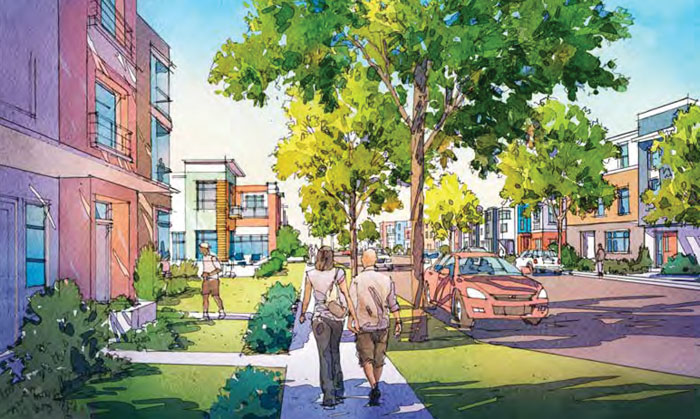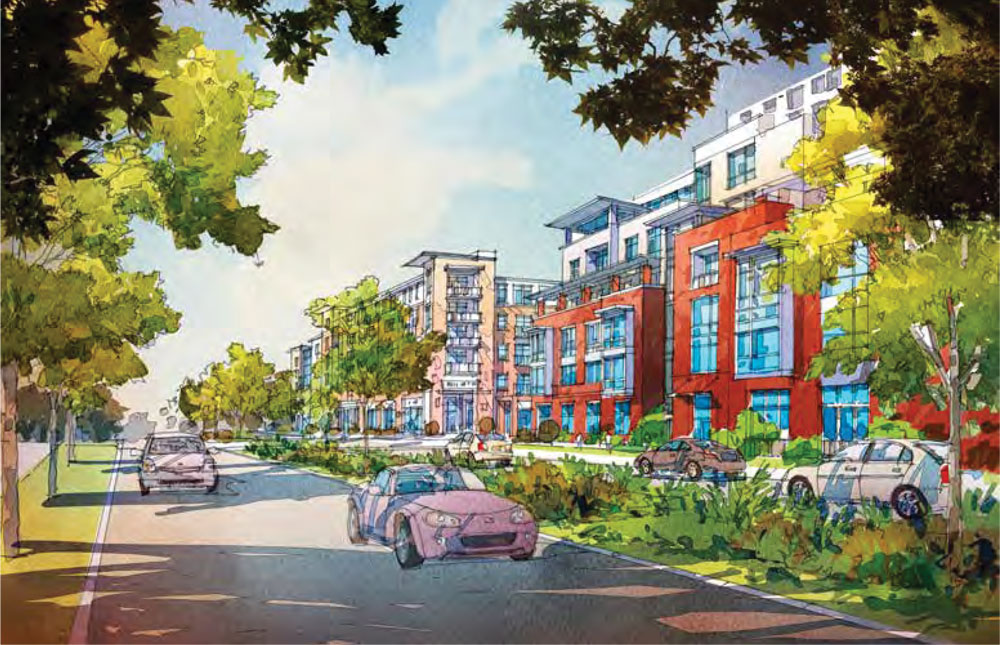All renderings courtesy of Metro Housing Authority
At her restaurant, Sweet Peaches, owner Pam Haines sits by the window that looks out at 18th Street and Muhammad Ali Boulevard. Over her shoulder, her son drizzles caramel sauce onto warm pecan rolls. The friendly 52-year-old with copper hair is taking a break, gazing at the corner as she often does. “It’s not pretty what I see,” she says. “There’s hopelessness.” Sometimes she spots disheveled men trekking to a day-labor spot just down the way. Sometimes it’s folks who’ve just been let out of jail and have heard that Haines will feed them a free warm meal. (She always does.)
Haines, who’s planning to open a second Sweet Peaches location in Parkland, is ready to see more: clothing shops or kids heading to a neighborhood skate park or a bookstore, maybe some of those oversized ornate flowerpots that dot sidewalks in trendy, bustling neighborhoods. The Choice Neighborhoods Initiative, or CNI, may achieve it.
A CliffsNotes version of CNI: It’s an updated version of the Department of Housing and Urban Development’s HOPE VI project, the goal of which was to transform public housing into mixed-income developments. Now the focus is not just on replacing distressed public housing but also investing in and lifting up entire neighborhoods. In December, Mayor Greg Fischer beamed as he held a ceremonial $29.5 million check from HUD to revitalize the Russell neighborhood (bounded by Market and Ninth streets, I-264 to the west and Broadway).
Haines says the Louisville Metro Housing Authority and Mayor Fischer seem determined to make Russell — an area plagued by high rates of poverty, unemployment and crime — into a thriving community. (The crime rate in Russell is 2.8 times higher than the metro Louisville average; 60 percent of residents live in poverty; and 20 percent of housing units are vacant.) “The mayor’s not playing about this part of town,” Haines says.
The city hopes to leverage an additional $200 million for projects that will attract businesses, target vacant and abandoned properties, and hopefully transform Muhammad Ali west of Ninth into an arts and cultural strip. “(Russell) is so well situated to just explode, with its proximity to everything — downtown and the river,” says Tim Barry, executive director of the Louisville Metro Housing Authority. And with 1,400 historic homes and buildings, many of which boast Italianate and Victorian design, the hope is that Louisvillians will start eyeing Russell as a place full of potential.

A lot of planning on how to achieve Russell’s renaissance is underway. One of the first projects? A three- or four-story senior-housing complex at Ninth and Ali, where Old Walnut Street Park sits. (Either retail or service amenities for seniors will fill the first floor.) Harold Williamson, who owns commercial property in Russell, was disappointed when he heard this. Bored, even. “We’re all looking forward to Choice, and what’s the first thing we’re going to do? We’re building a senior-housing complex,” he says, sighing. Williamson is all for great elderly housing, but the announcement seemed anti-climactic to him. (Many Russell residents asked for more senior housing in community meetings related to CNI. And Barry promises it will be a “wow” building.)
Because this is the first CNI project in Louisville and is a seven-year endeavor, how and what the finished product will look like is unclear. Here’s what we know.
What will $29.5 million accomplish?
Most of that money will focus on Beecher Terrace, one of the city’s last barracks-style public-housing complexes, built in 1939. The $29.5 million grant will pay for demolition, relocation of residents, case management and construction of new mixed-income units. Relocation may begin at the end of this year.
So the whole grant goes to Beecher?
Nope. Up to 15 percent of the grant must go to so-called Critical Community Improvements (CCIs). One CCI project will provide financing for the Village @ West Jefferson, a 30,000-square-foot office/retail development adjacent to Beecher Terrace. Other CCI projects include home-rehab programs, a media production center at the Kentucky Center for African American Heritage, micro business loans and low-interest loans for businesses to expand or relocate to Russell.
Where will the additional $200 million come from?
That $200 million figure is a goal. Metro government has looked at possible funding streams like low-income housing tax credits, tax-exempt bonds, grants, LMHA funds and money from nonprofits like Metro United Way.
What areas beyond Beecher will be targeted for revitalization?
Home to Sweet Peaches and the Kentucky Center for African American Heritage, the area around 18th and Muhammad Ali is a logical first step. “We’re going to be working with property owners or different divisions of the city to get site control (of vacant and underused properties), so we can support commercial development of that corridor,” says Jeana Dunlap, director of the city’s Office of Redevelopment Strategies. The area around Cedar Street will be targeted for home ownership. Cedar Street is part of the Russell Urban Renewal Initiative, a 27-year-old project that’s partnered nonprofits with the city to build new housing and improve streets and sidewalks.

What are the first visible changes people will see?
Aside from the senior housing mentioned earlier, beautification will pop up first. LMHA received a $1 million “action grant” from HUD (that was matched with $375,000 from the city) that must go toward immediate, visible change. One focus will be the 14th Street railroad overpass from Market to Broadway. Currently, the city is seeking artists and muralists to spruce it up. Another goal is to bring a water feature to Sheppard Park and design attractive, unconventional bus stops in the area.
Who will return to the newly developed housing where Beecher is now?
Beecher has 758 units. LMHA will replace those public-housing units, but many will be scattered throughout the city and not on-site. Built in six phases over the next seven years, the new 640 Beecher units will break down this way: 20 homeownership units, 172 market-rate units, 132 units for families making up to $53,600 per year and 316 units for very low-income families (meaning a family of four making $33,500 or less annually; Beecher’s current median household income is $9,439). LMHA and most housing authorities across the country preserve a percentage of new units for low-income households. This allows original residents the chance to return, and since HUD requires that every demolished public-housing unit be replaced, it makes sense to start on land LMHA already owns. Expect the new Beecher Terrace to have more restrictions, like a no-smoking policy. Those who fill out rental applications will probably have to clear a criminal-background check.
Any unknowns or concerns?
A 2013 study of Choice Neighborhoods by the Urban Institute, titled “A Brief Look at the Early Implementation of Choice Neighborhoods,” showed that neighborhoods with a lot of momentum before the awarded CNI grant had the most dramatic and efficient revitalizations. For instance, the Tremé neighborhood in New Orleans received its CNI grant in 2011. But a lot of attention and money had already pumped into the neighborhood after Hurricane Katrina in 2005.
In Louisville’s Choice application, the Walmart at 18th and Broadway and the $58 million Food Port were both cited as evidence that Russell was on the upswing. Both projects have since been abandoned. The city’s response? Fear not. “We’ve been bombarded with a lot of entrepreneurs and small businesses that have heard about the synergy in Russell who want to find a space,” Dunlap says. “The issue is with long-term vacancy; it’s not like you have property owners standing there ready to list their property, ready for people to move in. That’s why the city’s vacant-property programs are so important to make those connections.”
Any chance that changes in Washington, D.C., could make the whole thing just disappear?
The good news is, the money for Louisville’s grant has already been approved and appropriated by Congress. Still, Barry says, “Whenever there is a change in administration there’s always concerns — not of it being defunded, but the process slows a bit.” For example: The formal grant agreement hasn’t been signed yet because, as of mid-February, Ben Carson hadn’t been sworn in as HUD secretary. Therefore, the next step — a request to make the first of seven withdrawals on the $29.5 million — will also be delayed.
Any cool stuff to look forward to?
The new Beecher Terrace site will include a fitness center, swimming pool and revamped community center. A new neighborhood park located at Beecher Terrace’s western edge will have basketball courts, playing fields and may be named after Muhammad Ali.
This originally appeared in the March 2017 issue of Louisville Magazine. To subscribe to Louisville Magazine, click here. To find your very own copy of Louisville Magazine, click here.


